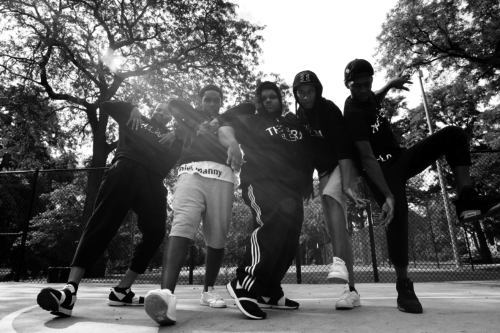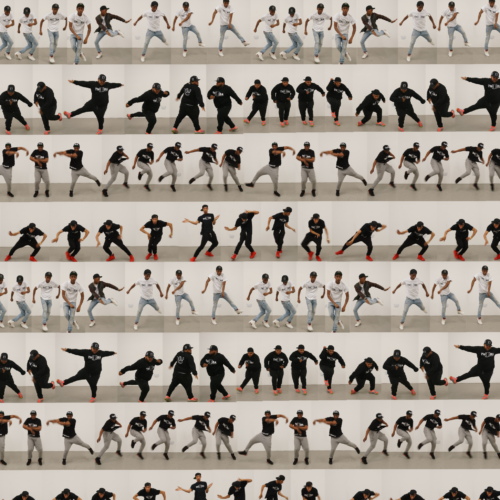The basement area of BING Art Books is a strange space. There’s not much to it—some brick and concrete, basically—but it comes together nicely to create a near-eerie feel under the otherwise pleasant bookstore. It was here, on a late-May evening, that Chicago footwork dance crew The Era, close kin of DJ Rashad’s legendary Teklife label, gave a crash course on the origins and developments of footwork—a wide, but often unseen, world.
Most listeners outside of Chicago have discovered footwork, a hyper-aggressive derivative of house music, relatively recently—more than a decade after the invention of the dance and the music associated with it. A series of notable early-2010s releases like Planet Mu’s Bangs & Works Vol. 1 (A Chicago Footwork Compilation), Addison Groove’s “Footcrab,” and, of course, the popularization of Chicago’s Teklife crew, led to a boom in interest in the genre across Europe. The music seemed odd, complex, and even alien to many listeners.
But some five years after this international “debut,” footwork has spread further afield than any of its earliest pioneers might have dreamed—producers in Japan and Berlin dabble in the style, and trendsetting magazines like Pitchfork and FACT run features about upcoming footwork releases. Somehow, a genre that was originally described as impenetrably insular—a 2010 piece in The Guardian called Bangs and Works Vol. 1 “a snapshot of a world most people outside Chicago never knew existed, thrillingly strange and alien” has become one of the most in-vogue styles for experimental producers and DJs.
For many casual electronic music listeners, footwork productions remain listenable and even enjoyable, but impenetrable for the body. But as many of the videos shown in the basement of BING demonstrated, the history of footwork lies not simply in its appeal to international listeners and fans of progressive electronic music—in fact, that’s merely a sideshow for many of Chicago’s footworkers.
Through a series of videos played in the basement of BING, members of The Era and their affiliates trace the history of footwork not just to its recent popularization, but much, much further back. Early-aughts productions like “Let Me See Your Footwerk” and recordings of the “House O’ Matics” from the 1990s reveal, through subdued but astonishing footage, just how long the genre has been “Bang’n on King Drive” (the street is only one block east of BING) and through the basements of generations of dancers. One of the videos captures scenes of dozens of children footworking through the streets of Chicago for the annual Bud Billiken Parade. The footwork dancers and producers in attendance mention obscure-to-most names and cliques as “legends.”
As the evidence piles, it becomes abundantly clear that footwork isn’t just a small “scene” in a few neighborhoods of Chicago—rather, it’s laced through the city, a part of its lifeblood vital to artists and families alike.

In a later conversation I had with footwork documentarian Wills Glasspiegel and Litebulb, one of The Era’s foremost teachers, the bonds that the music has forged and strengthened over the years became even more apparent. “When you do something that has meaning creatively,” Glasspiegel says, “it starts to resonate out. And what we realized was that this thing that was made for very intimate circumstances in South Chicago—it was meaningful. And as you realize it’s connected to struggles and music and creativity across time—it’s great to be realizing that, ‘cause there’s so many options for what you can do and what footwork can be channeling.”
Of course, in the abstracted, experimental world of Berliners and tastemakers that have come across footwork, dance may be important, but it’s often ancillary, a simple result of the speed and infectiousness of the music in the genre. But back here in Chicago, the dance of footwork and the “friendly competition” that comes with it, which is mentioned throughout the night and in my later conversations—is what the genre is based on: what keeps it from being a niche concern for music geeks and instead turns it into a pulse underneath the city.
“We as DJs, we are nothing without [the dancers],” noted genre mainstay and producer Traxman later in the night.
The Era led a panel upstairs in the bookstore after the viewing. It included some of the best-known progenitors of the footwork sound along with newcomers and lesser-known (but just as important) luminaries. Listening to legends like Traxman and RP Boo exchange stories about their own histories with the genre alongside the relatively young members of The Era, the most notable thing about the conversation wasn’t any individual story, but rather the casual ease with which the history started pouring out.
At one point, an audience member asked with bated breath, “So, where did the 160 bpm come from? How did you guys decide on that?”
“Oh yeah, I came up with that,” answered Traxman, smiling wistfully. It’s that dismissive approach to history—Oh yeah, I came up with that—that reminds an onlooker of just how current the “history” of this genre really is.
The members of The Era are aware of this, of course—even their name, “The Era,” is a reference to the here and now, this era, the time that they have to tell the history of footwork and to build the next steps for the genre. They hope to help even more people have revelations like the one I had in BING—realizations of just how far back this genre goes, and how important this music and these dances are to the soul of Chicago itself. They’ve done plenty of work to this end already: the group recently received a sponsored residency at the University of Chicago’s Arts and Public Life, which helped put on the BING event, and they’ve spread the genre’s story through articles in The FADER, as well as Vice’s electronic music vertical, Thump. They’ve even helped teach classes on footwork in Japan, where Litebulb and Glasspiegel say both the sound and dance of the genre have taken hold.

Despite all this, The Era seem to see their group’s place in footwork’s history up to this point little more than a practice round. They’re interested in educating and simply moving their bodies, of course, but the rich tradition of choreographic dance—and the narratives within—that footwork is a part of (as Litebulb and Glasspiegel describe it) run just as deep. Right now, they’re most excited about their upcoming “debut stage performance” in Hamilton Park on August 27. They go into just enough description about this performance to entice, but they also seem to enjoy keeping it somewhat under wraps. They do let me in on one detail—the performance will include lyrical performances, what Litebulb describes as “footworking with words.”
“It’s pretty much about the everyday footwork experience, you know,” says Litebulb of the upcoming performance. “Being able to look at Chicago through our day-to-day lives and what we go through. A key element is helping to put things in perspective for the footwork world—just showing how we develop and what we’re working towards.”
After the panel, I went back downstairs and saw all the musicians and dancers from the panel congregating in the basement again. The space was filled with dancers gyrating and flailing with impossible precision while their friends and fellow artists looked on—the space that had seemed bare turned out to be a great place to dance. I crouched down to ask Glasspiegel (manning a camera) if it would be possible to ask them a few questions.
“Could you maybe wait a bit?” he said. “These guys have been looking forward to this all night.”
So I sat there watching for a minute instead, as Glasspiegel took pictures of the dancers whipping their feet and legs in time to a relentless thump of the beat, taking full advantage of the time they had to relax—if you want to call it that—after a long day of living.
The Era will be debuting their “In The Wurkz” performance in Hamilton Park on August 27.

